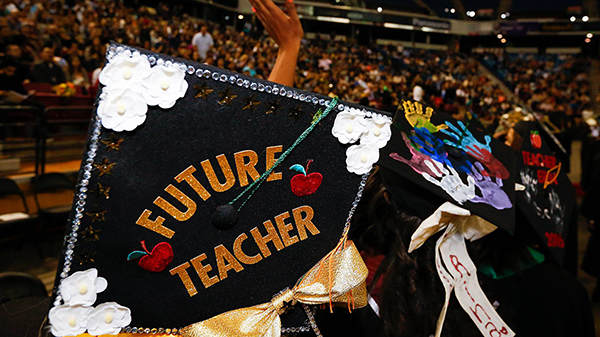 Sacramento State teaching candidates earned a significant share of scholarships offered by California State University under a new program. (Sacramento State/Jessica Vernone)
Sacramento State teaching candidates earned a significant share of scholarships offered by California State University under a new program. (Sacramento State/Jessica Vernone)
By Jonathan Morales
As a new California State University teaching scholarship program rolls out, Sacramento State students are benefiting in a big way.
Out of 278 awards given systemwide as part of the new CSU Residency Year Service Scholarship Program, Sacramento State teaching candidates have received a remarkable 103 – and a total of nearly $1 million in scholarship money to help defray the cost of obtaining a credential.
The scholarships are funded through a $3.1 million grant from the S. D. Bechtel, Jr. Foundation to support recruiting and retaining teacher candidates into California’s high-need schools.
The program benefits students who are participating in “teacher residencies,” a relatively new and innovative way of structuring student teaching that can include up to a year in the same classroom and specialized support and training for “cooperating teachers” who can better facilitate their professional development.
Traditional student-teaching models place candidates in multiple schools throughout the year for shorter periods, the idea being that variety can enhance the student teaching experience.
But that model has drawbacks, says Pia Wong, associate dean of the College of Education. The candidate has less time to develop a productive relationship with the cooperating teacher and is not able to experience the full arc of an entire school year in one place. And the K-12 students themselves must adapt to a new adult in the classroom every few weeks.
Residencies, on the other hand, allow candidates to spend up to an entire school year in one location, developing stronger relationships with K-12 students and fully learning the ins and outs of the school and district in which they are placed. Candidates also benefit from a deeper and more collaborative relationship with the cooperating teacher, who receives specialized training and support for their mentoring role. K-12 students have more stability, and, if the district has any job openings at the end of the year, they are likely to have an applicant who is ready to hit the ground running.
"It's very much like the medical residency model,” Wong said. “It's trying to be systematic and thoughtful about how we bring new teachers into the profession."
Sacramento State has used the residency model since 2012 in its single-subject credential program, which is which primarily designed for future high school teachers. The elementary school-focused multiple subject credential program began to incorporate the model about two years ago. The special education credential programs are beginning to implement a residency program, though the effort is not connected with the CSU initiative.
The University’s history with residencies meant an abundance of applicants for the scholarship, and Wong credited Teaching Credentials Chair Deidre Sessoms with both lobbying the CSU to increase Sac State’s allocation from an initial 63 to 103 and with conducting special outreach sessions to encourage eligible candidates to apply.
“We’re definitely on a wave with a lot of other programs, but particularly in the single-subject program and then the innovations they are trying to make in the multiple-subject programs, we’re with the likes of the advanced surfers,” she said.
The scholarship money can be a lifeline for teacher candidates, who are typically unable to work while they complete the yearlong credential program. That was the case with Kelvin Martinez, a single-subject credential candidate who received $10,000 in scholarship money. Martinez, a first-generation college student who had taken out loans to fund both his undergraduate degree and credential, called the award “life-changing.”
“When I found out I won a scholarship, I called my mom tearing up,” said Martinez, who used the money to pay off student loan and medical debt. “I was like, ‘Mom, I did it. I actually got it.’ She cried, too. It was a big impact not just for me but for my whole family.”
He has been in residency at Rosemont High School since the fall, and said he definitely feels the benefits of a longer-term and more collaborative student-teaching experience.
“It’s been really rewarding. Definitely challenging, but rewarding,” Martinez said. “It helps with moving the day along and seeing the same faces every day, and definitely allows me to make a bigger impact in (the students’) lives because I can keep building that rapport.”
